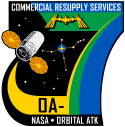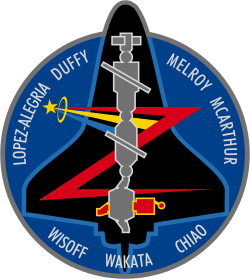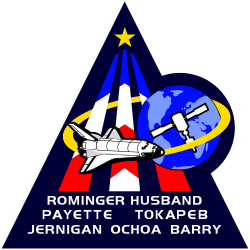Unity (ISS)
- För andra betydelser, se Unity.
| Unity (Node 1) | |
 | |
| Status | Aktiv |
|---|---|
| Rymdstation | ISS |
| Beställare | NASA |
| Tillverkare | Boeing |
| I omloppsbana | 25 år, 8 månader och 9 dagar (13 augusti 2024) |
| Uppskjutning | |
| Uppskjutning | 4 december 1998, 08:35:34 UTC[1] |
| Uppskjutningsplats | Kennedy Space Center LC-39A |
| Raket | STS-88 Endeavour |
| Dockning | 6 december 1998, 02:07 UTC |
| Mått | |
| Vikt | 11 612 kg |
| Längd | 5,47 m |
| Diameter | 4,57 m |
| Dockningsportar | |
| Antal portar | 6 st |
| Porttyp | Common Berthing Mechanism |
| För | Destiny |
| Akter | Pressurized Mating Adapter |
| Styrbord | Quest Airlock |
| Babord | Tranquility |
| Zenit | Truss Z1 |
Unity (eller Node 1) är en amerikansk trycksatt modul på den internationella rymdstationen ISS.
Unity var den första modul som NASA sköt upp. I december 1998 levererade och installerade rymdfärjan Endeavour Unity till den av Ryssland tidigare uppskjutna modulen Zarja. Unity är en viktig del av ISS, som förbinder de ryska delarna av rymdstationen med de övriga. Unity är navet i ISS för viktiga funktioner som luft, temperatur ombord, elektricitet, data, vätskor och kommunikationsutrustning. Unity är byggd av aluminium och har mer än 50 000 mekaniska delar, 216 rör för gaser och vätskor och 121 invändiga och utvändiga elektriska kablar med nästan tio kilometer tråd.
Anslutningar
Unity har sex anslutningar: för, akter, styrbord, babord, zenit (ovanpå) och nadir (under). Alla är av typen Common Berthing Mechanism.
- För: Här är det amerikanska laboratoriet Destiny anslutet. Tidigare var PMA-2 ansluten här.
- Akter: Här är modulen Zarja ansluten, via PMA-1.
- Styrbord: Här sitter Quest Airlock.
- Babord: Modulen Tranquility med Cupola. Cupola har bland annat panorama-fönster vända mot jorden. STS-120 installerade här tillfälligt Harmony som sedan flyttades av Expedition 16 till sin permanenta placering framför det amerikanska laboratoriet Destiny.
- Zeni: Här sitter Z1 truss.
- Nadir: Används under bygget av rymdstationen för trycksatta lagringsmoduler och dockning av rymdfärjor. Sedan 2015 använder de olika Cygnus rymdfarkosten porten.
Dimensioner och vikt
Unity är 5,49 meter lång, har en diameter på 4,57 meter och väger ungefär 11,5 ton.
Uppskjutning
Unity sköts upp tillsammans med två Pressurized Mating Adapter och installerades i december 1998, av STS-88.
Dockningar


| Farkost / Modul | Port | Dockning (UTC) | Urdockning (UTC) | |
|---|---|---|---|---|
| Zarja (PMA-1) | Akter | 6 december 1998, 02:07[2] | ||
 | Discovery STS-96 (PMA-2) | För | 27 maj 1999, 10:49:42 | 6 juni 1999, 02:02:43 |
| Atlantis STS-101 (PMA-2) | För | 20 maj 2000, 04:30 | 26 maj 2000, 23:03 | |
 | Atlantis STS-106 (PMA-2) | För | 8 september 2000, 12:45:47 | 19 september 2000, 07:56 |
 | Discovery STS-92 (PMA-2) | För | 11 oktober 2000, 23:17 | 24 oktober 2000, 20:59:47 |
| PMA-3 | Nadir | oktober 2000 | mars 2001 | |
 | Endeavour STS-97 (PMA-3) | Nadir | 2 december 2000, 19:59 | 9 december 2000, 19:13 |
 | Atlantis STS-98 (PMA-3) | Nadir | 9 februari 2001, 16:51 | 16 februari 2001, 14:05 |
| PMA-3 | Babord | mars 2001 | augusti 2007 | |
| Leonardo (MPLM) | Nadir | mars 2001 | mars 2001 | |
| Raffaello (MPLM) | Nadir | april 2001 | april 2001 | |
| Quest Airlock | Styrbord | 15 juli 2001, 07:40[3] | ||
| Leonardo (MPLM) | Nadir | augusti 2001 | augusti 2001 | |
| Raffaello (MPLM) | Nadir | december 2001 | december 2001 | |
| Leonardo (MPLM) | Nadir | juni 2002 | juni 2002 | |
| Raffaello (MPLM) | Nadir | juli 2005 | augusti 2005 | |
| Leonardo (MPLM) | Nadir | juli 2006 | juli 2006 | |
| PMA-3 | Nadir | augusti 2007 | 2009 | |
| Harmony | Babord | 26 oktober 2007, 15:57 | 14 november 2007 | |
| För | 14 november 2007 | |||
| PMA-3 | Babord | 2009 | 25 januari 2010 | |
| Leonardo (PMM) | Nadir | 1 mars 2011, 15:05 | 27 maj 2015, 09:46 | |
 | Cygnus CRS OA-4 | Nadir | 9 december 2015, 14:26 | 19 februari 2016, 10:38 |
 | Cygnus CRS OA-6 | Nadir | 26 mars 2016, 14:52 | 14 juni 2016, 11:43 |
| Cygnus CRS OA-5[4] | Nadir | 23 oktober 2016, 14:53 | 21 november 2016 | |
 | Cygnus CRS OA-7 | Nadir | 22 april 2017, 12:39 | 4 juni 2017, 11:05 |
 | Cygnus CRS OA-8E | Nadir | 14 november 2017, 12:15 | 5 december 2017, 17:52 |
 | Cygnus CRS OA-9E | Nadir | 24 maj 2018, 12:13 | 15 juli 2018, 10:20 |
| Cygnus NG-10 | Nadir | 19 november 2018, 12:31 | 8 februari 2019, 14:37 | |
 | Cygnus NG-11 | Nadir | 19 april 2019, 11:31 | 6 augusti 2019, 15:00 |
 | Cygnus NG-12 | Nadir | 4 november 2019, 11:21 | 31 januari 2020, 13:10 |
 | Cygnus NG-13 | Nadir | 18 februari 2020, 11:16 | 11 maj 2020, 13:00 |
 | Cygnus NG-14 | Nadir | 5 oktober 2020 | 6 januari 2021 |
 | Cygnus NG-15 | Nadir | 22 februari 2021, 11:00 | 29 juni 2021, 16:32 |
 | Cygnus NG-16 | Nadir | 12 augusti 2021, 13:42 | 20 november 2021, 13:40 |
 | Cygnus NG-17 | Nadir | 21 februari 2022, 12:02 | 28 juni 2022, 07:00 |
 | Cygnus NG-18 | Nadir | 9 november 2022, 13:05 | 21 april 2023, 08:37 |
 | Cygnus NG-19 | Nadir | 4 augusti 2023, 12:28 | 22 december 2023, 10:00 |
 | Cygnus NG-20 | Nadir | 1 februari 2024, 12:14 | 12 juli 2024, 08:00 |
Källor
- Faktablad från NASA i pdf-format. (Engelska)
- ”Visiting Vehicle Launches, Arrivals and Departures” (på engelska). NASA. https://www.nasa.gov/feature/visiting-vehicle-launches-arrivals-and-departures.
Fotnoter
- ^ Manned Astronautics - Figures & Facts, Unity Arkiverad 5 oktober 2015 hämtat från the Wayback Machine., läst 17 augusti 2016.
- ^ Manned Astronautics - Figures & Facts, Zarja Arkiverad 27 oktober 2016 hämtat från the Wayback Machine., läst 17 augusti 2016.
- ^ Manned Astronautics - Figures & Facts, Quest Arkiverad 5 oktober 2015 hämtat från the Wayback Machine., läst 17 augusti 2016.
- ^ Manned Astronautics - Figures & Facts Arkiverad 29 december 2016 hämtat från the Wayback Machine., läst 28 december 2016.
| |||||||||||||||||||||||||||||||||||||||||||||
Media som används på denna webbplats
NASA insignia for Orbital ATK's OA-7 resupply flight
NASA insignia for Orbital's OA-6 resupply flight
NASA's patch representing Northrop Grumman's Cygnus NG-20 commercial resupply services (CRS) mission.
- This flight will be the first of two to launch on a SpaceX Falcon 9, which seems to have inspired the shape of the patch.
This is the crew insignia for STS-97, which will deliver, assemble, and activate the U.S. electrical power system on board the International Space Station (ISS). The electrical power system, which is built into a 47-foot integrated truss structure known as P6, consists of solar arrays, radiators, batteries, and electronics. P6 will be attached to the Station using the Shuttle's robotic arm in coordination with spacewalking crewmembers that will make the final connections. The spacewalkers will then prepare P6 for the subsequent deployments of the large solar arrays and radiator, which are critical steps in the activation of the electrical power system. The 120-foot solar arrays will provide the power necessary for the first ISS crews to live and work in the U.S. segment.
NASA logo for Northrop Grumman's NG-13 Cygnus, the second Commercial Resupply Services (CRS)-2 mission
NASA insignia for Orbital's OA-4 resupply flight
The STS-101 mission patch commemorates the third Space Shuttle flight supporting the assembly of the International Space Station (ISS). This flight's primary tasks are to outfit the ISS and extend its lifetime, and to conduct a spacewalk to install external components in preparation for the docking of the Russian Service Module, Zvezda, and the arrival of the first ISS crew. The Space Shuttle is depicted in an orbit configuration prior to docking with the ISS. The ISS is depicted in the stage of assembly completed for the STS-101 mission, which consists of the United States-built Unity module and the Russian-built Zarya module. The three large stars represent the third ISS mission in the assembly sequence. The elements and colors of the border reflect the flags of the nations represented by the STS-101 crew members, the United States and Russia. The NASA insignia design for Shuttle flights is reserved for use by the astronauts and for other official use as the NASA Administrator may authorize. Public availability has been approved only in the form of illustrations by the various news media. When and if there is any change in this policy, which is not anticipated, it will be publicly announced.
NASA logo for Northrop Grumman's NG-12 Cygnus, the first Commercial Resupply Services (CRS)-2 mission
NASA insignia for Orbital ATK's OA-10E resupply flight
This is the insignia for STS-98, which marks a major milestone in assembly of the International Space Station (ISS). Atlantis' crew will deliver the United States Laboratory, Destiny, to the ISS. Destiny will be the centerpiece of the ISS, a weightless laboratory where expedition crews will perform unprecedented research in the life sciences, materials sciences, Earth sciences, and microgravity sciences. The laboratory is also the nerve center of the Station, performing guidance, control, power distribution, and life support functions. With Destiny's arrival, the Station will begin to fulfill its promise of returning the benefits of space research to Earth's citizens. The crew patch depicts the Space Shuttle with Destiny held high above the payload bay just before its attachment to the ISS. Red and white stripes, with a deep blue field of white stars, border the Shuttle and Destiny to symbolize the continuing contribution of the United States to the ISS. The constellation Hercules, seen just below Destiny, captures the Shuttle and Station's team efforts in bringing the promise of orbital scientific research to life. The reflection of Earth in Destiny's window emphasizes the connection between space exploration and life on Earth.
NASA logo for Northrop Grumman's NG-16 Cygnus, the fifth Commercial Resupply Services (CRS)-2 mission
NASA insignia for Northrop Grumman's NG-11 Cygnus resupply flight
NASA logo for Northrop Grumman's NG-15 Cygnus, the fourth Commercial Resupply Services (CRS)-2 mission
The Unity module inside the shuttle payload bay of Space Shuttle Endeavour.Endeavour is scheduled to fly on mission STS-88, the first Space Shuttle flight for the assembly of the International Space Station, on December 3, 1998. The primary payload on the mission is the Unity connecting module, which will be mated to the Russian-built Zarya Control Module already in orbit at that time.
ISS Unity module (NASA) taken by STS-88 mission in December 1998
NASA insignia for Orbital ATK's OA-9E resupply flight
NASA logo for Northrop Grumman's NG-14 Cygnus, the third Commercial Resupply Services (CRS)-2 mission
NASA insignia for Orbital ATK's OA-5 resupply flight
NASA insignia for Orbital ATK's OA-8 resupply flight
Designed by the crew members, the STS-92 patch symbolizes the second mission to carry U.S.-built elements to the International Space Station (ISS) for assembly. The black silhouette of the Space Shuttle Discovery stands out against the deep blue background of space in low Earth orbit. In the foreground in gray is a profile view of the ISS as it appears when the shuttle and crew arrive, with the station consisting of the Unity node, its two pressurized mating adapters (PMA), the Zarya functional cargo block, the Zvezda service module, and the Progress cargo vehicle.
Following the shuttle's rendezvous and docking, the ISS configuration will be augmented by the two elements delivered by Discovery–the Z1 truss and PMA-3. These two elements, depicted in red, will be installed using the shuttle's robot arm and be connected to ISS during four spacewalks. The multi-national nature of both the STS-92 crew and the ISS are reflected in the multi-colored Astronaut Office symbol.
With Unity in place, Astronaut Nancy Currie begins positioning Zarya for mating.
Designed by the crew members, this is the mission insignia for the STS-96 space flight, the second Space Shuttle mission dedicated to the assembly of the International Space Station (ISS). The crew patch highlights the major themes of the Station Program: Earth-directed research, the advancement of human space exploration, and international cooperation. The Space Shuttle Discovery is depicted shortly after reaching orbit as the crew prepares to carry out the first docking with the new Station. At this early stage in its construction, ISS consists of two modules: Zarya and Unity, shown orbiting Earth. The triangular shape of the patch represents building on the knowledge and experience of earlier missions, while the three vertical bars of the astronaut emblem point toward future human endeavors in space. The five-pointed star that tops the astronaut emblem in this depiction is symbolic of the five space agencies participating in the development of ISS: NASA, the Russian Space Agency, the European Space Agency, the National Space Development Agency of Japan, and the Canadian Space Agency. The blend of red, white, and blue is a tribute to the nationalities of the crew members who are from the United States, Canada, and Russia.
This is the crew patch for the STS-106 mission, which is the first Shuttle flight to the International Space Station since the arrival of its newest component, the Russian-supplied Service Module Zvezda (Russian for star). Zvezda is depicted on the crew patch mated with the already orbiting Node 1 Unity module and Russian-built Functional Cargo Block, called Zarya (sunrise), with a Progress supply vehicle docked to the rear of the Station. The International Space Station is shown in orbit with Earth above as it appears from the perspective of space. The Astronaut Office symbol, a star with three rays of light, provides a connection between the Space Shuttle Atlantis and the Space Station, much the same as the Space Shuttle Program is linked to the International Space Station during its construction and future research operations. Stylized versions of flags from Russia and the United States meet at the Space Station. They symbolize both the cooperation and joint efforts of the two countries during the development and deployment of the permanent outpost in space as well as the close relationship of the American and Russian crew members.
NASA's patch for the Northrop Grumman Cygnus NG-18 commercial services resupply mission.
NASA logo for Northrop Grumman's NG-17 Cygnus, the sixth Commercial Resupply Services (CRS)-2 mission
NASA's patch for the Northrop Grumman Cygnus NG-19 commercial services resupply mission.
- The mission is slated for March 2023 and will mark the final launch using an Antares 230+ rocket.



























